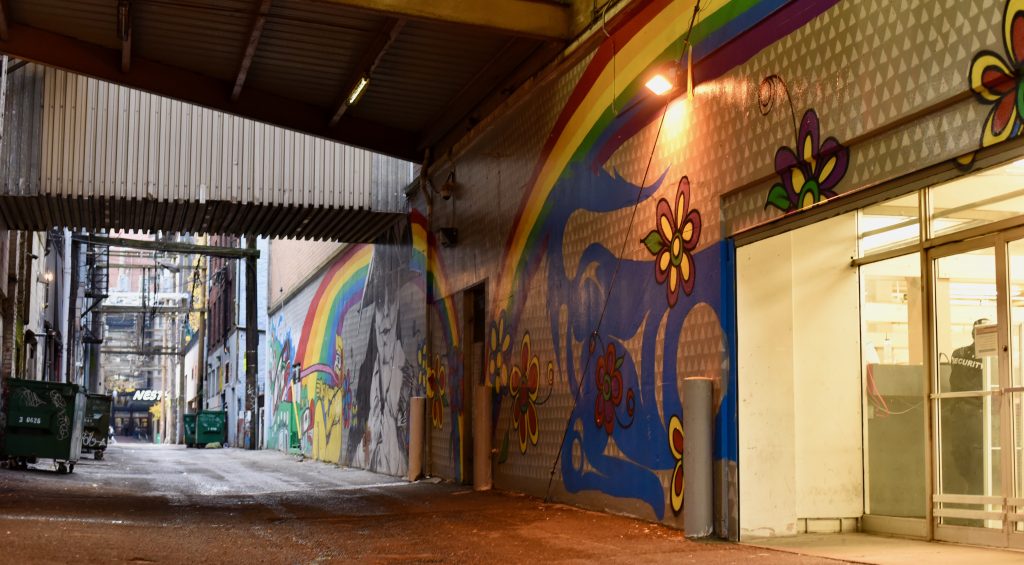Indigenous public art gains visibility in Vancouver
More than two dozen works by Indigenous artists have appeared in Vancouver since 2010
Larissa Healey’s aerosol mural, Bringing Darkness into Light, dominates an alley in the Downtown Eastside with its portrayal of healing from the fentanyl crisis.
For Healy, a graffiti artist who identifies as Anishinaabe, the chance to create art in the alley behind Vancouver’s Army & Navy was a dream for years.
“It changed a lot of people’s lives, especially mine,” Healy said of the 20-day painting process with co-creator Shadae Johnson and community members who chipped in.
That mural, completed in late summer, is just one of more than two dozen works by Indigenous artists that have appeared in Vancouver since 2010.
Within a seven-year span, the City of Vancouver has commissioned 13 significant permanent works and 20 temporary works by Indigenous artists. In total, approximately one quarter of recent commissions in its public-art program are done by Indigenous artists.
“It’s really picked up,” said Healy, who has worked with the city’s art program for more than 20 years.

Bringing Darkness into Light was one of six commissions by Indigenous artists for the Canada 150+ mural program, which drew in 47 applicants, 70 per cent of whom were applying for a city commission for the first time.
The mural includes representations of Anishinaabe flowers, rainbows to represents two-spirited people, a traditional Squamish weave pattern, and Peter White, a traditional dancer who Healy describes as a good example for youth.
“We poured everything we had into it,” Healy said. “It’s sort of only now beginning to settle in and word is getting out and people are appreciating it. It’s really nice to see and feel.”

For many Indigenous communities, celebrating Canada 150 was controversial because Indigenous people believed it negated the fact they lived on the land thousands of years prior to confederation.
Healy acknowledged that but wanted to participate anyway.
“To be granted 150 Canada, there’s a lot of issues around Canada’s birthday. So my elders taught me we can either sit there and grump and gripe, or we can do something about it.”
Young artists taking notice
Young Indigenous artists in the city like Suna Galay are noticing the increase in Indigenous representation through public art, but still would like to see more of it.
“It’s important to me because I feel the voice of the land is the most important voice of any space, and I feel it is expressed with the people who have interacted with that land and protected that land for a really long time,” Galay said.
In the Vancouver area, that voice is of the Musqueam, Squamish and Tsleil-Waututh First Nations. In the 2016 census, 61,455 people in the Lower Mainland identified themselves as Aboriginal.
James Harry, an artist of Squamish and European descent working in sheet metal and carvings, agrees there needs to be more Indigenous art in the city.

“Recently I’ve been thinking a lot about Indigenous public art in the city because I feel like there isn’t enough representation of it. Especially within the context of contemporary Indigenous art, because people romanticize Indigenous people as something stuck in the past,” Harry said.
“I know (the airport) does a great job of doing that when people are first greeted into Vancouver, but I’d like to see more representation in the city and the Lower Mainland.”
Harry’s modern totem pole design from sheet metal is featured at the Vancouver International Airport, which hosts the world’s largest collection of Northwest Coast native art.
Listen to James Harry talk about the process of carving in public.

Modernizing ideas of Indigenous art
Healy, Galay and Harry all agreed that public art can modernize people’s ideas of Indigenous culture and spark interest in learning about Indigenous art.
“In media representations of native culture, there is a lot of glorification, like the noble savage idea,” Galay said. “And so that’s not really acknowledging modern culture or being a native today.”
Galay completed a non-city-commissioned mural for St. Paul’s church in the Downtown Eastside that depicts the interweaving of Catholicism and Northwest Coast Native symbols of the wolf, raven, whale and frog in April 2016.
“The process of weaving Catholicism with the native population was absolutely tragic, and still the result is a lot of people have adopted and accepted that religion into their way of being, like my own family,” Galay said whose family is Métis Chippewa from Saskatchewan.
“So as far as reconciliation goes, I think that piece is bringing those two points together. Like acknowledging what is reality now.”
Greater consultation with local First Nations
Since becoming a “city of reconciliation” in 2014, Vancouver has moved toward deeper engagement and consultation processes with its local First Nations.
In addition to consultation on specific major projects, the city’s Aboriginal relations manager, Ginger Gosnell-Myers, has started up a process of quarterly city meetings to discuss relevant upcoming projects that that require analysis and input from the three nations.
Eric Fredericksen, senior public art planner at the City of Vancouver, said Indigenous artists are being consulted about the new waterfront being planned for former industrial land in Northeast False Creek.
“There are artists working on temporary projects that extend out of the Northeast False Creek planning. That’s a really significant Indigenous site and that’s also a way of connecting to the concentration of urban Aboriginal people living nearby in Strathcona, Downtown Eastside or other eastern neighbourhoods that connect to Northeast False Creek,” Fredericksen said.
Three of the eight artists involved in the project planning are Indigenous.
Fredericksen also hopes a second mural call-out for Indigenous artists will happen in 2018. For young muralists like Galay, it could be the chance to contribute public art that has as strong an impact as Healy’s.
